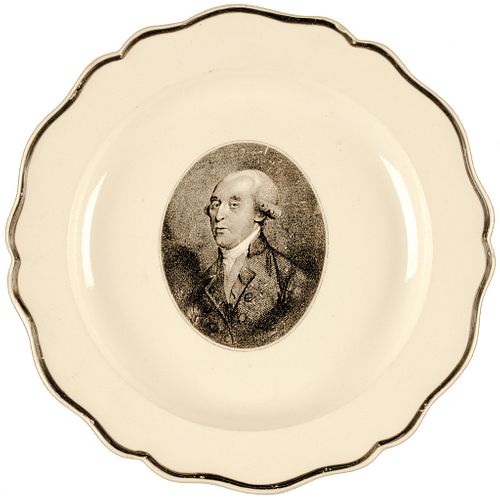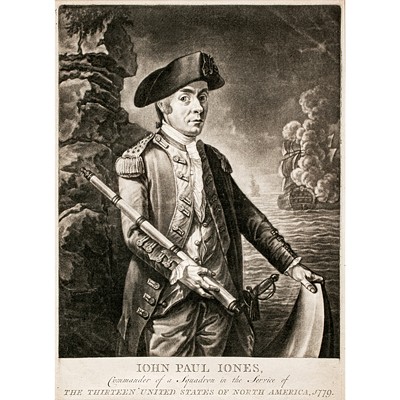1812 Unique 4th U.S. President James Madison Portrait Historical Liverpool Plate
Lot 236
Categories
Estimate:
$6,500 - $8,500
Absentee vs Live bid
Two ways to bid:
- Leave a max absentee bid and the platform will bid on your behalf up to your maximum bid during the live auction.
- Bid live during the auction and your bids will be submitted real-time to the auctioneer.
Bid Increments
| Price | Bid Increment |
|---|---|
| $0 | $10 |
| $200 | $20 |
| $300 | $25 |
| $500 | $50 |
| $1,000 | $100 |
| $2,000 | $200 |
| $3,000 | $250 |
| $5,000 | $500 |
| $10,000 | $1,000 |
| $20,000 | $2,000 |
| $30,000 | $2,500 |
| $50,000 | $5,000 |
| $100,000 | $10,000 |
| $200,000 | $20,000 |
| $300,000 | $25,000 |
| $500,000 | $50,000 |
About Auction
By Early American History Auctions
Jan 23, 2021
Set Reminder
2021-01-23 12:00:00
2021-01-23 12:00:00
America/New_York
Bidsquare
Bidsquare : Early American History Auction of Autographs, Americana, Political & Maps
https://www.bidsquare.com/auctions/early-american-history-auctions/early-american-history-auction-of-autographs-americana-political-maps-6311
311 Lots of Rare, Historic Autographs, Americana, Civil War Era, George Washington, Abraham Lincoln, Slavery & Black History, Revolutionary War Era, Colonial America, Federal Period, War of 1812, Colonial Currency, Indian Peace Medals & more... Early American History Auctions auctions@earlyamerican.com
311 Lots of Rare, Historic Autographs, Americana, Civil War Era, George Washington, Abraham Lincoln, Slavery & Black History, Revolutionary War Era, Colonial America, Federal Period, War of 1812, Colonial Currency, Indian Peace Medals & more... Early American History Auctions auctions@earlyamerican.com
- Lot Description
Glass and Porcelain
Extremely Rare President "James Madison" Portrait Liverpool Plate This The Only Recorded Example Known
c. 1812, War of 1812 Period, Possibly Unique Extremely Rare President James Madison Portrait, 4th President of the United States, Historic Liverpool Creamware Plate, 10" Diameter, Choice Near Mint.
Arman notes only one recorded example and lists its value at $9,000 (or more) back in 1990. This beautiful example is possibly Unique. President James Madison is shown facing to the left on this 10" Liverpool plate in virtual mint condition. Although not identified in the portrait, an identical example with the name "James Madison" printed below is illustrated on page 133, listed as M.5 in the major reference "Anglo-American Ceramics" by Arman.
James Madison (1751-1836) was an American Statesman, the Fourth President of the United States (1809-1817) and is hailed as the "Father of the Constitution" for being instrumental in the Drafting of the United States Constitution, and as the key champion and author of the United States Bill of Rights. He inherited tobacco land and owned Slaves although he spent his entire adult life as a career politician.
This impressive Plate is similar to other Transferware pieces produced for Madison's predecessor, Thomas Jefferson. Madison Portrait Plate pieces are exceedingly rare. The black transfer is much as originally made and there is a Hand-painted outer black highlight to the rim, with just one small chip on the rim edge at 1:00. This one was likely only used for display purposes since first sold, as it is a particularly pleasing, bold and highly distinctive form for display.
After the United States Constitution had been drafted, Madison became one of the leaders in the movement to ratify the Constitution. His collaboration with Alexander Hamilton and John Jay produced the Federalist Papers (1788), which were only circulated in New York at the time, but would later come to be seen as one of the most famous polemics in support of the Constitution.
Madison was also a delegate to the Virginia constitutional ratifying convention, and was instrumental to the successful ratification effort in Virginia. Like most of his contemporaries, his political views changed over his life. During the drafting and ratification of the constitution, he favored a strong national government, though later he grew to favor stronger state governments, before settling in in between the two extremes late in his life.
In 1789, Madison became a leader in the new House of Representatives, drafting many basic laws. In one of his most famous roles, he drafted the first ten amendments to the Constitution and thus is known as the "Father of the Bill of Rights".Madison worked closely with President George Washington to organize the new federal government.
Breaking with Hamilton and what became the Federalist party in 1791, Madison and Thomas Jefferson organized what they called the Republican Party (later called by historians the Democratic-Republican Party) in opposition to key policies of the Federalists, especially the national bank and the Jay Treaty. He co-authored, along with Thomas Jefferson, the Kentucky and Virginia Resolutions in 1798 to protest the Alien and Sedition Acts.
As Jefferson's Secretary of State (1801-1809), Madison supervised the Louisiana Purchase, doubling the nation's size. After his election to the presidency, he presided over renewed prosperity for several years. As president (1809-17), after the failure of diplomatic protests and an embargo, he led the nation into the War of 1812.
The War of 1812 was in response to British encroachments on American honor and rights as well as to facilitate American settlement in the Midwest which was blocked by Indian allies of the British. The War was an administrative nightmare without a strong army or financial system, leading Madison afterwards to support a stronger national government and a strong military, as well as the national bank that he had long opposed.
- Shipping Info
-
Early American provides in-house worldwide shipping. Please contact us directly if you have questions about your specific shipping requirements.
-
- Buyer's Premium



 EUR
EUR CAD
CAD AUD
AUD GBP
GBP MXN
MXN HKD
HKD CNY
CNY MYR
MYR SEK
SEK SGD
SGD CHF
CHF THB
THB












